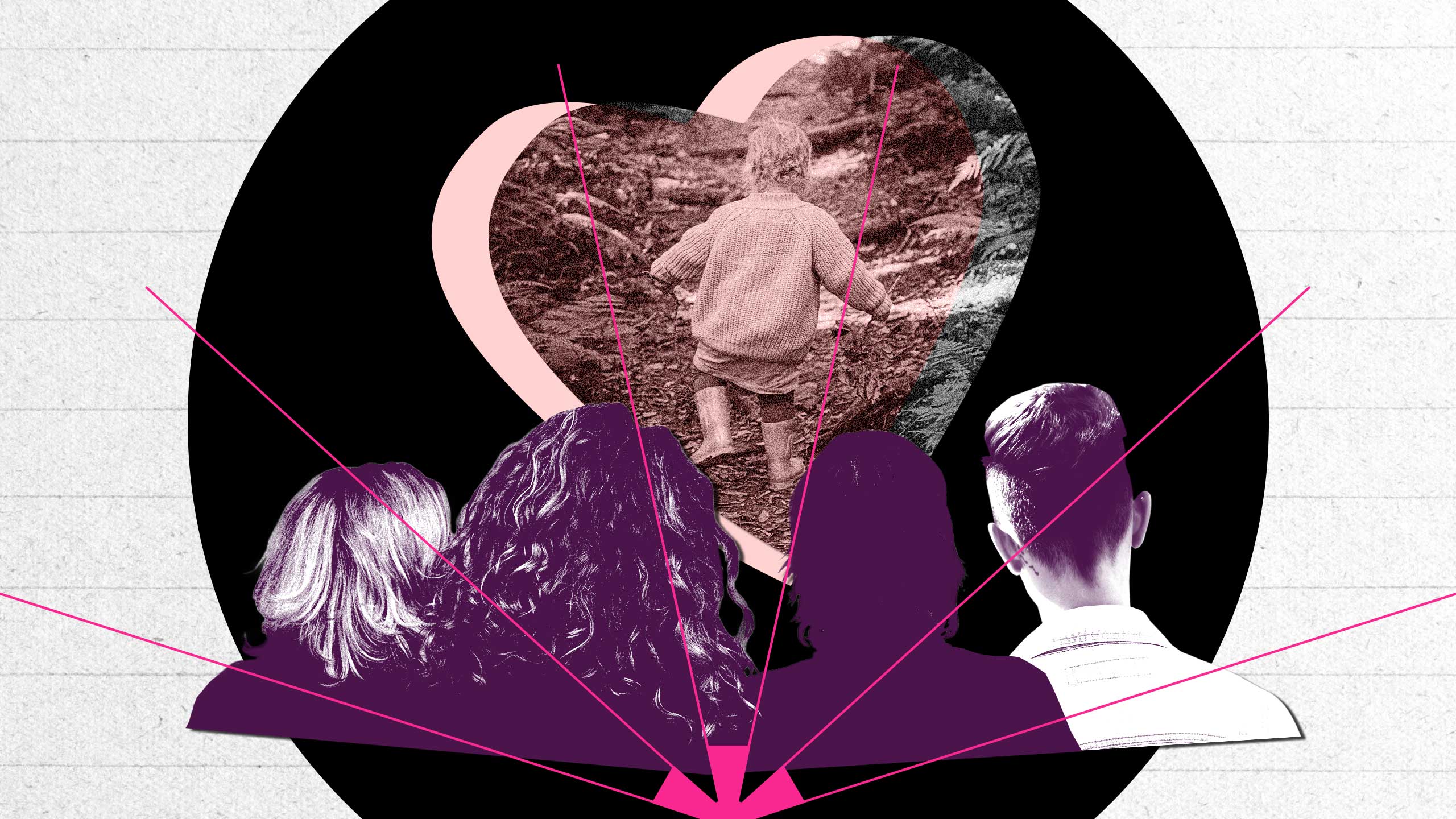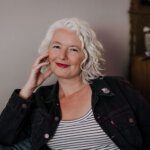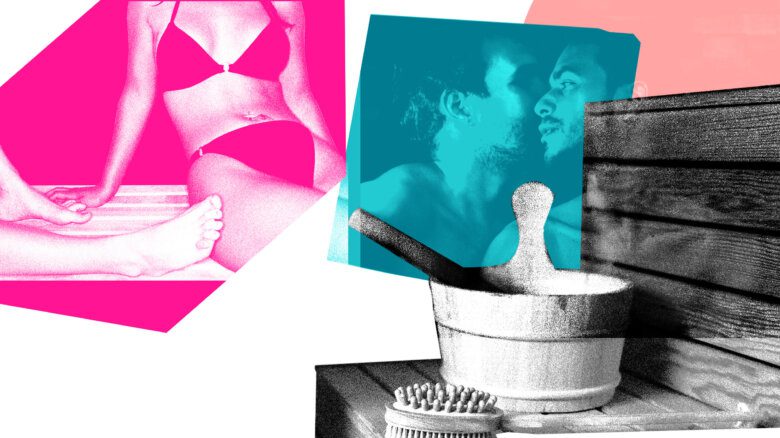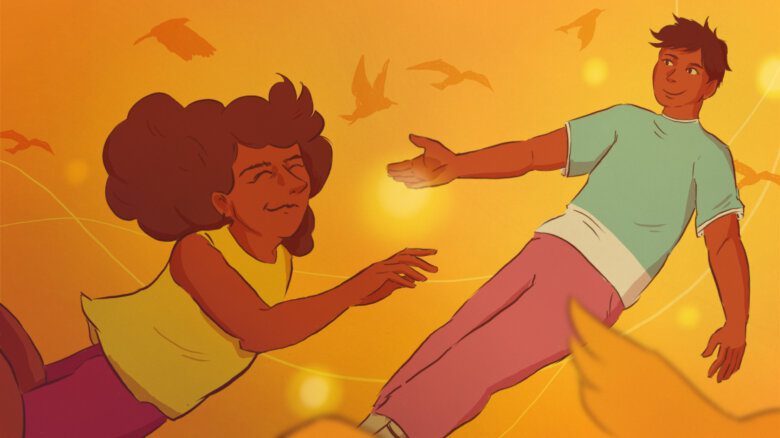For many years the idea of becoming a parent felt impossible to me. Although I’d always loved kids, I spent most of my twenties and thirties rejecting the prospect of parenthood, content to be a queer femme auntie to the children in my life. I was one of those people who would sit in my favourite neighbourhood brunch restaurant smugly enjoying my hot coffee and peaceful breakfast as the parents at the table beside me struggled to eat their rapidly-cooling meals while wrangling toddlers and rescuing dropped food and toys from the floor. Sure, I would sign up to deliver meals when my friends had babies, and I was a reliable source of adorable tiny outfits and thoughtfully curated children’s books. But parenting felt like another planet, one I didn’t understand the customs of and never planned to visit.
I surprised everyone, including myself, when I became a parent in my late thirties. Now you’re more likely to find me crawling under the kitchen table to rescue a kid-sized fork or pick up stray goldfish crackers than enjoying a leisurely solo brunch. I spent last Saturday night having a living room dance party with my three-year-old, twirling in circles to Taylor Swift songs until we collapsed on the carpet in a giggling heap, then getting up and doing it all over again. I couldn’t have imagined this life for myself during the years I spent rejecting the idea of becoming a parent. When my kid was born, the whole structure and cadence of my life changed, and so did my priorities. The love I feel for my kid is tender, joyful and fierce and it keeps growing and deepening all the time.
Today, I look at my past self with empathy and curiosity: Why did parenting feel so impossible to me for so long, and what changed? I also feel some regret that I wasn’t more available in the past to support my friends with kids or more helpful to the parents sitting beside me in our neighbourhood café. I understand now that it takes a whole community to raise a child, and that parents and caregivers need their communities to show up for them, too. I know this because what makes it possible for me to be a parent today is that I’m doing it with three other people.
I came into parenthood through what I thought would be a casual hookup—although the path from that night to our kid’s birth took years, not months.
Before my partner Scout and I had sex for the first time, we sat on the worn, wooden steps of a small building in the forest near the rustic retreat centre where we were staying and had a short conversation about our STI status, anyone else we were dating and the parameters of what we would and wouldn’t do with each other. Our desire was electric, our words hinting at what might happen between us later. In the background, the nearby lake glinted with sunlight like a knowing wink.
At one point in our conversation, Scout announced, “Oh yeah, I might be pregnant.” Their intention was to give me a heads-up that they were trying to have a baby, so they’d recently had their donor’s semen in their body, not to invite me into co-parenthood. I appreciated the courtesy but didn’t give it much thought—I figured this would be a one-time encounter with the tall enby babe with capable hands, a playful spirit and a wide grin.
It turns out Scout wasn’t pregnant that night and fate had other plans for our supposedly casual encounter. There was a spark between us and we decided to keep meeting up for regular dates. Over time, our relationship deepened, and after several months of seeing each other, I surprised myself by falling in love with Scout. Scout’s ongoing efforts to get pregnant suddenly carried new significance for me as I contemplated what it would mean to be partnered with a parent. Who would I be to their kid, and how would I fit into the relationships and plans Scout already had with the two other queer people they planned to co-parent with? Answering those questions took several years and brought me to where I am today.
Our four-parent family structure has its roots in a deep friendship between Scout and Linden, a queer femme who’s long been part of Scout’s chosen family. They’d both always wanted children but kept dating people who didn’t or weren’t ready to have kids, so years ago they committed to co-parenting together as friends. They held fast to this commitment when Linden met her partner Jen a decade ago, and their family structure evolved to include her.
When Scout and I started dating several years later, I knew it was a package deal. This prompted me to reflect on how I might be able to join their family and become a parent in a way that felt authentic to my identity and dreams. I wanted wherever I ended up to be rooted in possibilities and joy, not feelings of desperation, unsustainable compromises or decisions driven by fear of losing a romantic partner I loved.
Scout, Linden, Jen and I also had conversations about how I would fit into their family. Parenting together is a significant, intimate and long-term commitment. It was important for us to talk about things like each of our parental roles, our values and parenting styles and how we would navigate the legal and financial dimensions of our commitments to each other. Together, we found our way into a family structure that worked for all of us, an ongoing negotiation as we continue growing into our relationships with our child and with each other.
In practice, this means my kid has four parents, two queer couples co-parenting together. In our family, there are two lead parents—my partner, Scout, and co-parent Linden— and two vice-parents—Jen and me. The leads do more of the day-to-day (and night-to-night) work, carry a bigger share of the mental load of parenting and have greater decision-making authority over things like our kid’s health and development. On a typical day, you’ll find them packing toddler-approved lunches and snacks, managing the logistics of daycare drop offs and pick ups, strategizing together about our latest child development questions and skillfully coaxing our kid back to sleep. Us vice-parents also have active roles as parents and caregivers—feeding, dressing and bathing our toddler, helping them with the potty, playing with them and helping with naps and bedtime. The difference is that as vice-parents, we have more flexibility and autonomy than parenting typically affords; we’re not in charge the same way the lead parents are. It’s easier for us to tap in and out.
Scout, who is non-binary, gave birth to our kid. Scout and Linden are named as our child’s parents on their birth certificate, and all four parents are named as their legal guardians in each other’s wills. My experience is that the law and other government systems still don’t know quite what to make of families like ours. Our family’s approach has been to get the paperwork necessary to protect our kid’s interests and navigate a system not built for us, without spending thousands of dollars on legal fees.
While there’s an abundance of parents in our family (three of whom are cis women), none of us identify as mothers. Instead, we each chose a parent name of our own—I go by ZeeZee, a variation on my first name. We’re raising our child gender-open, which means we didn’t assign them a gender when they were born and will refer to them using gender-neutral pronouns until they tell us otherwise. When our kid was small and people used to ask if they were a girl or a boy, we’d answer, “They’re a baby!” A stranger at a pool once got really angry with us about this, stalking off with a harrumph when we didn’t give an answer to her satisfaction. I remember feeling fiercely protective of my family in that moment, the sun beating down on my skin as I burned with rage at this nosy stranger.
“When our kid was small and people used to ask if they were a girl or a boy, we’d answer, ‘They’re a baby!’”
My co-parents and our toddler live together in the suburbs in a small grey townhouse, tucked beside a creek, that I think of as the family home. Each week I split my time between there and an apartment in the city where I live alone, though we’re working to realize a dream of living together in a house that’s big enough for all of us. We share responsibility for things like cooking dinner, washing the dishes and putting our kid to bed, so everyone gets nights off each week. At times the logistics feel more complex than I imagine they might in a two-parent family—like when we’re co-ordinating the details of four people’s work schedules, volunteer commitments and daycare pick ups and drop offs—and four adults means four different personalities and parenting styles. Still, it’s a family structure that feels both sturdy and expansive to me, and it gives our kid the benefit of having four devoted parents who each have different skills and strengths.
This has been especially evident during the COVID-19 pandemic as we’ve weathered the challenges of working full-time while parenting our young child, including several months where we had no access to daycare or any outside support from family or friends. Unlike many people in my circles, we’ve been able to take regular breaks from parenting because our co-parents are there to pick up the slack. One night last May, Jen and Linden gave Scout and me the gift of a beautifully cooked three-course meal, then put our kid to bed so we were free to savour our candlelit dinner and have the rest of the night to ourselves. Pandemic parenting has been hard at times, but having four parents in our family has buffered us from the intense stress and overwhelm that other caregivers are contending with as they juggle childcare with the demands of their jobs.
When I try to understand what made parenting feel impossible to me for so many years, I think about my experiences growing up. I’m an only child and my mom raised me on her own. My dad wasn’t in the picture and we lived in poverty in a city far from her relatives, so my mom didn’t have access to family support or help with parenting. She was devoted to me and embraced her role as my mother, but I know being a single parent was hard and she struggled at times. I internalized a story that parenting is a thing you do alone without breaks or help; as an adult, I felt afraid of having a child be so dependent on me.
For a long time, my definition of family was a tight circle: Just my mother and me. It took me years to understand this was a manifestation of intergenerational trauma in my own family. The isolation my mom and I experienced was a result of weakened or intentionally severed ties between us and the relatives who might otherwise have been part of our support network. Plus, being poor meant we lived in a different apartment every year and this made it harder to build relationships with our neighbours.
As a white settler, I’ve come to understand how being raised in a society centred around the nuclear family and state-sanctioned marriage, which have their roots in white supremacy and settler colonialism, shriveled my ability to imagine broader and deeper forms of kinship. These are the same forces that violently controlled or sought to eradicate the vibrant and richly complex kinship networks central to Indigenous communities. This context shaped the narrow set of assumptions I internalized about what family and parenting could look like; years later, I’m still working to unlearn those assumptions and learn new forms of interdependence by practicing different ways of creating family.
This learning started when I came out as queer in my early twenties and expanded my definition of what family could be. Still, I resisted the idea of parenting even as I created and nurtured a chosen family bigger and more interdependent than anything I’d experienced growing up. When some of my friends became parents, I was glad to welcome their children into our community, but I continued carrying those same old fears. A few people I knew were parenting on their own but most were doing it with a romantic partner, a queer take on the nuclear family that’s come to dominate mainstream representations of LGBTQ2S+ families. What I saw of the 24/7 work of parenting intimidated me, and I was convinced I would suck at doing it full-time. The idea of sharing this work with only one other adult—someone mainstream society told me I was supposed to somehow also nurture a vibrant romantic relationship with—felt inaccessible to me.
I wish I’d known then about the long history of multi-parent family structures in the LGBTQ2S+ community. Writer Michael Waters documents some of this history in a Slate article called “Life in a Four-Mom Family,” where he shares stories of kids who were raised by four moms in the 1970s, and cites a 1979 interview with a woman who co-parented a baby alongside 10 lesbian friends. This collective orientation to caring for children was reflected in LGBTQ2S+ activism, too. In 1972, the Boston-based group Gay Men’s Liberation released a list of political demands that stated, “Rearing children should be the common responsibility of the whole community… Free twenty-four hour child care centers should be established where faggots and lesbians can share the responsibility of child rearing.” They called for the dissolution of parents’ legal rights over “their” children so that each child could be “free to choose their own destiny.”
“I wish I’d known about the long history of multi-parent family structures in the LGBTQ2S+ community.”
At the 1979 National Third World Gay and Lesbian Conference, Audre Lorde gave a keynote speech where she spoke of raising children as an act done in and with communities, describing children as “our joint responsibility and our joint hope.” Her perspective was informed by a long history and ongoing practice in Black communities of kinship and child rearing beyond the boundaries of what the state might recognize as a “legal” family. Alexis Pauline Gumbs traces this Black queer feminist genealogy for radical mothering in the book Revolutionary Mothering, which is where I first learned about this speech by Lorde.
I’ve sought out this history as I’ve figured out how to situate myself in a lineage of queer parenting and family-making that feels more aligned with my pathway into parenthood. It’s a reminder that how we define and create family can be both a form of resistance and a means of survival, particularly in the face of pernicious norms of what a “good” or “normal” family looks like. As the reproductive justice movement—a movement founded and led by Black women—taught me, these norms and the state apparatus that supports them reward some families (especially ones led by straight, white, non-disabled, middle-class married couples) and seek to discipline or eliminate others.
The fact I’m able to parent this way and share my family’s story is in itself a reflection of our privilege. My co-parents and I are white, middle-class and non-disabled; we aren’t surveilled by social workers, living in fear of child apprehension by the state or dependent on income assistance that tries to restrict who we live with or call family. We’re out about our family structure to our neighbours, co-workers and daycare providers, and my co-parents’ extended families have embraced us and our kid, who has many enthusiastic grandparents. And since our family is made up of two couples, we don’t experience stigma in the same way poly families with different configurations of romantic or sexual relationships among the adults might. I also recognize that there are many people who want to become parents or parent their own children and can’t for a whole host of individual and structural reasons. The ability to be a parent at all is a privilege in and of itself. I don’t take any of this for granted.
Today I know several queer people co-parenting with a friend or in three- or four-parent families. You can read stories like the one queer Ottawa journalist Matthew Pearson shared about his four-parent family; a recent article in The Atlantic on the rise of the three-parent family centres asexual activist David Jay, his two co-parents and their daughter. Multi-parent families are increasingly visible in Canada and the U.S., with laws in some jurisdictions changing to reflect the many ways people create families or become parents. Ontario’s 2016 All Families Are Equal Act allowed up to four parents to be listed on birth certificates, and, in 2018, a court in Newfoundland and Labrador recognized three adults in a polyamorous relationship as legal parents of their child.
Creating family on our own terms is one way LGBTQ2S+ people have ensured our community’s survival across generations; our definitions of family far exceed what is legible to the state and its institutions. I keep having conversations with queer and trans people younger than me who are curious to learn more about how things work in my family. They tell me they want kids but they don’t want to parent alone or with a romantic partner; they’re looking for examples of alternative ways to create families and raise children together beyond the confines of the nuclear family or the ideal of monogamous romantic love. I’m trying to be the example I needed to see ten or even twenty years ago, in the hope I might help expand someone’s sense of what might be possible for them.
One of the traditions I love most in our family is gathering together for meals around the kitchen table. Before we eat, we often pause and press our palms together to create a circle and sing a song of gratitude for our meal. As we sing, we look around the table, meeting each other’s eyes with a smile. At the end of the song, everyone exclaims, “Thank you!”—something our toddler always does with gusto and a grin on their small, bright face. I always feel such gratitude in those moments, not just for the meal but for the family I’ve found my way into and the gift of being able to parent in a way that enables us all to thrive.


 Why you can trust Xtra
Why you can trust Xtra


